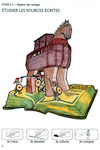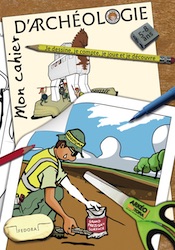Finding Archaeological Remains Using Ancient Writings
- Last Updated: Tuesday, 28 June 2022 10:12
- Published: Saturday, 19 February 2022 16:39
- Written by Jean-Olivier Gransard-Desmond translated by Christiane Angibous-Esnault and Kimberly Merren
- Hits: 1368
Join Augustin, Alex, Lisa and the whole ArkeoTopia team to discover additional resources for step 2.1 in My Archaeology Book about locating human presence through ancient writings.
Step 2.1 - Locating Archaeological Remains
Study Written Sources
Corresponding pages in MAB1 and MAB2
MAB 1, p. 6 and p. 25 (step 1.3 on p. 7 and p. 25 in 1st edition) and MAB 2, pp. 7-8 and p. 31
More about the step’s reference artifact
 The drawing in My Archaeology Book titled Study Written Sources are based on the Iliad and the Odyssey attributed to Homer, an aedic poet of the 8th century BCE, nicknamed “the Poet”.
The drawing in My Archaeology Book titled Study Written Sources are based on the Iliad and the Odyssey attributed to Homer, an aedic poet of the 8th century BCE, nicknamed “the Poet”.
After the death of the great heroes of both sides, Hector and Achilles, the Trojan War is at a halt because neither side can prevail on the battlefield. Inspired by Athena, Ulysses imagined a ruse to take over the city: to bring into Troy a gigantic wooden horse containing about twenty warriors. It is Epaios, an architect and carpenter, who is in charge of the construction.
The episode of the Trojan horse is briefly first told by Homer in the Odyssey, his Iliad stopping the narrative of the Trojan War at Hector's funeral. Although no machine has been found in Heinrich Schliemann's Troy discover, several Greek representations are known. For p. 6, we have chosen the life-size reconstruction of the Trojan horse from the Istanbul Archaeological Museum (image on the left) and for p. 25, we have chosen the representation of the Mykonos pithos (jar), dated to the Archaic period (around 670 CE) and preserved in the Mykonos Archaeological Museum (inv. 2240) in Greece (image on the right).
For p. 6, we have chosen the life-size reconstruction of the Trojan horse from the Istanbul Archaeological Museum (image on the left) and for p. 25, we have chosen the representation of the Mykonos pithos (jar), dated to the Archaic period (around 670 CE) and preserved in the Mykonos Archaeological Museum (inv. 2240) in Greece (image on the right).
Clues
The 2 clues include:
- The book as a support for the written source
- The title of the book as a text relating an event
These two clues refer to the idea of identifying a human settlement thanks to written sources, as Heinrich Schliemann did for the site of Troy, which was the subject of numerous archaeological excavations.
Discovery by ChanceMy Archaeology Book
Resources HomepageStep 2.2 - Location
Using Fieldwalking
 |
 |
|
My Archaeology Book 1 |
My Archaeology Book 2 |

 My Archaeology Book, or MAB, is an activity workbook that combines creativity, fun and learning. Alongside young Augustin, a curious and courageous boy, children meet Alex and Lisa, two friendly archaeologists who will lead them to discover archaeology and French heritage. Each drawing illustrates a situation that Alex and Lisa might encounter at work. Depending on the age of the child and the workbook, children follow easy-to-understand symbols in order to experiment with activities such as coloring, drawing, observation games, riddles and reading in order to see the world through an archaeologist’s eyes. Alone, with family, at school or just for fun, children expand their knowledge and gain skills, all while having fun.
My Archaeology Book, or MAB, is an activity workbook that combines creativity, fun and learning. Alongside young Augustin, a curious and courageous boy, children meet Alex and Lisa, two friendly archaeologists who will lead them to discover archaeology and French heritage. Each drawing illustrates a situation that Alex and Lisa might encounter at work. Depending on the age of the child and the workbook, children follow easy-to-understand symbols in order to experiment with activities such as coloring, drawing, observation games, riddles and reading in order to see the world through an archaeologist’s eyes. Alone, with family, at school or just for fun, children expand their knowledge and gain skills, all while having fun.
On this section, you will find additional resources: color photos of archaeological documents that inspired My Archaeology Book, additional teaching documents (flip-book, websites, suggestions for classroom use, edutainement, etc.) and information on upcoming publications. Each page will be updated over time.







